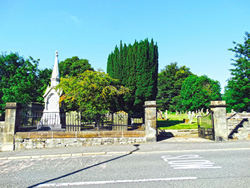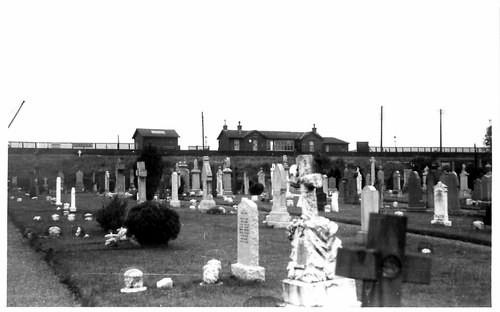Cemeteries
The Old Burial Ground, Barrhill Road
by George Scott
 Hundreds of years ago Cumnock people buried their dead in the Kirkyard - the area round the Parish Church, which we now know as The Square. This practice came to an end around 1768, but interments were being carried out in the ground adjacent to the Gallows Hill, on the Barrhill from 1756. Several Covenanters had been buried there, in the shadow of the scaffold, in the 17th century, ‘out of contempt’. But such was the reputation of these martyrs, that the Cumnock people had no qualms about burying their dead in adjacent lairs.
Hundreds of years ago Cumnock people buried their dead in the Kirkyard - the area round the Parish Church, which we now know as The Square. This practice came to an end around 1768, but interments were being carried out in the ground adjacent to the Gallows Hill, on the Barrhill from 1756. Several Covenanters had been buried there, in the shadow of the scaffold, in the 17th century, ‘out of contempt’. But such was the reputation of these martyrs, that the Cumnock people had no qualms about burying their dead in adjacent lairs.
After 1877, following the laying-out of a new cemetery beyond the New Station on Glaisnock Road, fewer burials were carried out at the Barrhill site, and only citizens who owned lairs in the old graveyard were entitled to arrange burials there. Occasional burials have been carried out in such family lairs within living memory.
A visit to this cemetery is of great interest. Even the limited wording on most of the headstones and memorials can give an impression of the way of life in those far-off days.
Cumnock Old Cemetery Monumental Inscriptions
by Bobby Grierson
During some family history research in 2010 I came across a copy of Cumnock and Doon Valley Monumental Inscriptions, indexes and maps on a website which included, amongst others, the Old Cemetery on Barrhill Road, Cumnock. This intrigued me as I had relations buried there.
Three years later when Cumnock History Group (CHG) was formed it was proposed to use these documents as the basis for a year-long project to examine and record the headstones in the cemetery – a visual stocktaking. When Tony Campbell joined the group we learned that it was he who had published the original inscriptions. He had found them in Cumnock Library a few years earlier but they were in a poor condition. When the Baird Institute archives was relocated to the Burns Monument Centre in Kilmarnock he found the original typed manuscripts and layout diagrams and was granted permission to copy them. It would appear that the inscriptions were gathered sometime in the late 1970’s or early 1980’s by a Manpower Services Commission project team. Their task was to record all pre 1918 monumental inscriptions and war memorials in the area covered by the former Cumnock and Doon Valley District Council. The complete set can be found HERE
In 2014 a small group of dedicated CHG members, Mary Dalgliesh, Morag Gordon, Mary Little and myself, spent the year photographing and cross-checking over 500 headstones with these inscriptions. It quickly became apparent that although many of the headstones were in good condition, many others had either seen marked erosion, disappeared, been vandalized, been overturned or were inaccessible due to overgrown shrubs, trees or undergrowth.
We also found some headstones that were not recorded in the original project. We found that some important information on the headstones themselves had been omitted.
We have now published these new updated inscriptions free of charge. You can download a free version HERE.
The accompanying USB Flashdrive loaded with a large pdf booklet of over 500 high quality photographs showing each headstone alongside the relevant inscription plus many added extras, is available for purchase on our site with any funds raised from sales being used to undertake further research into the history and heritage of Cumnock.
We would like to thank the original team from the Manpower Services Commission who undertook this huge and time consuming task. Without this important work we would have lost a large part of our heritage. If you were part of that team, please contact us!
We hope that other history groups will use the monumental inscriptions from the many other cemeteries in the area to conduct similar work.
Here are a few examples of the interesting information etched on the stones:-
30 - John Johnston, who was born in Sanquhar, and died in Cumnock in 1880, aged 99, had fought under Lord Nelson at Trafalgar in 1805. He had been in receipt of an Admiralty pension from 1871.
39 - Douglas Wills, a surgeon in Cumnock, died on 30th September, 1848 - “a victim of his zeal in the cause of humanity”.
297 - William Simson was born at Tenpoundland, near Ochiltree, in 1758 and studied at Glasgow University. He became the schoolmaster of Ochiltree in 1780, and then transferred to Cumnock in 1788. He died in 1815, age 57. He wrote a number of poems - including one to Robert Burns - who replied with his Epistle to William Simson in May 1785. Burns probably visited William in Cumnock and he gave him his name of Winsome Willie. William Simson died in 1815 and the stone in inscribed with a poem by Adam Brown Todd; “Here Winsome Willie lies whose worth in Burns woke equal. In love and death when wrenched the ties on earth has knit them now above.“
301 - A square-sectioned pillar reveals a unique, lengthy, and glowing tribute to a wife, who appears to have been the paragon of all virtues. Ann Menzies, daughter of Adam Menzies of Troloss, and spouse of Isaac Johnston, merchant in Cumnock, is lauded as follows:-
“For goodness of heart, free of all guile. For sincere honesty. As a friend. For Faithful affection as a wife. For preferring domestic happiness and decent economy to dissipated profusion. Equaled by few. Surpassed by none in justice to her worthy character. From the constant experience of eleven years, this conclusive testimony is inscribed by her afflicted husband as the last pledge of his heartfelt duty and most tender regard. She died May 20, 1776, aged 36 years.”
308 - Another stone marks the grave of James Taylor, ‘the inventor of steam navigation’, who died in 1825. Claims may be made that other people invented steam navigation, but it is well recorded that Taylor, assisted Patrick Miller and William Symington in the first successful effort to sail a boat powered by steam. Their boat traveled at 5 miles per hour on Dalswinton Loch in 1788. It is believed that Robert Burns - our National Bard - witnessed this ‘voyage’, - indeed it has been suggested that he may even have traveled on the boat. Taylor was a brilliant man, and he was afterwards brought to Cumnock by the Earl of Dumfries to develop coal-mining, industry, and transport and to set up the Cumnock Pottery on Glaisnock Street.
314 – Marion McMichael is buried very near to the Peden Monument. She held some Alexander Peden’s relics in safe keeping including his ‘fauce-face’, the mask he wore to hide his identity. This is now in the National Museum of Scotland in Edinburgh with a copy on display at the Baird Institute in Cumnock. Marion was visited at Mossend Farm to the west of Cumnock near Skares by the Rev James Murray, the Parish minister in the 1850s just before her death in 1858. The Rev Murray tells us what she said to him:
‘I have something here ye wad maybe like to see.’
She reported that Mr Peden’s brother was her great-grandfather.
‘This,’ opening the box and drawing forth what appeared to be a mass of long black hair, ‘was mister Peden’s wig. And here is the fause-face he wore in hiding.’
Then she showed a little oval-shaped metal box, which she said, ‘was where he keepit his tobacco, honest man’. she then produced a short rapier, in a sheath of leather, and explained, ‘this is his bit sword, but its not likely it ever did meikle mischief. Here is his stick too,’ she said, ‘and ye can see it has a whistle in the heid o’t. Ye can try’t as ye like. Some say it was a bird’s call, but it was nae sic things he whistled, I’se answer for it. It was only by sic means that poor folks could ane anither ken where they were, when sair pit by the enemy, or when the mist cam doon on them when they were separated.’
Marion is my 5th great grandmother.
323 - Fairly near the Simson stone is the grave of Annie Merry, wife of John Merry, Vintner, in Cumnock. Annie, as a young girl, was the Annie Ranken, who inspired Burns to compose the famous The Rigs O Barley, or Corn Rigs which is still enthusiastically sung at many a Burns Supper.
“It was upon a Lammas night, when corn rigs are bonnie, beneath the moon’s unclouded light, I held awa’ to Annie; The time flew by, wi’ tentless heed; Till, ‘tween the late and early, wi’ sma’ persuasion she agreed to see me thro’ the barley.
Corn rigs, an’ barley rigs, an’ corn rigs are bonnie; I’ll ne’er forget that happy night, among the rigs wi’ Annie.
The sky was blue, the wind was still,
the moon was shining clearly; I set her down, wi’ right good will, amang the rigs o’ barley: I ken’t her heart was a’ my ain; I lov’d her most sincerely; I kiss’d her owre and owre again, amang the rigs o’ barley.
I lock’d her in my fond embrace; Her heart was beating rarely: My blessings on that happy place, amang the rigs o’ barley! But by the moon and stars so bright, that shone that hour so clearly! She ay shall bless that happy night amang the rigs o’ barley.
I hae been blythe wi’ comrades dear; I hae been merry drinking; I hae been joyfu’ gath’rin’ gear; I hae been happy thinking: But a’ the pleasures e’er I saw, tho’ three times doubl’d fairly... That happy night was worth them a’, amang the rigs o’ barley.”
479 – At the beginning of 1833 a band of organised poachers, believed to be from the Glasgow area, were apprehended by a group of local voluntary constables and kept at the Dumfries Arms hostelry. Consequently, a group of about 300 local supporters set free one of the poachers and in the ensuing riot, David Reid a Mason from Barshare and one of the constables, was shot dead. His wife Marion Murdoch erected a headstone in memory of her husband and his tragic death.
534 - The inscription on this covenanting tombstone, believed to have been erected by Robert Paterson ‘Old Mortality’ reads “Here lyes David Dun and Simon Paterson who was shot in this place by a party of highlanders for their adherence to the word of God and the covenanted work of the Reformation 1685.” Dun is said to be from Closs, in Ochiltree - others say he may be from Selkirkshire.
529 - Thomas Richard was a tenant farmer at Greenock Mains, near Muirkirk. At the age of 80 he was taken from his farm by Peter Inglis and brought to trial at Cumnock under Colonel Douglas. He was executed as a covenanter in Cumnock Square on 5th April 1685. His corpse was taken to the Gallows Knowe (normally used for criminals) and he is the first covenanter buried on this spot.
528 - The most famous burial is the Rev Alexander Peden who, despite not having been put to death, was nevertheless a victim of persecution, and harassment for most of his adult life. For a period of several years he was incarcerated on the bleak Bass Rock in the Firth of Forth. His life was probably curtailed by the many privations and the cold, suffered as he wandered the country, preaching (illegally) the doctrines of the Presbyterian Kirk. Peden has the doubtful distinction of being buried twice! He died in Auchinleck Parish but, the dragoons who had been unsuccessful in capturing him – having got to hear of his burial in Auchinleck Kirkyard, dug up his body after six weeks, and transported it to Cumnock, with the aim of hanging it in chains on the gibbet. They were prevented from doing this, but they buried his body in the shadow of the scaffold – a terrible insult to the memory of a holy man, whose name will always be associated with the history of the Covenanters. This is the reason for the phrase on his gravestone inscription, “Buried here out of contempt”.
There are, no doubt, many other interesting epitaphs to be discovered on a visit to this ancient necropolis.
Ayr Advertiser 1 June 1888
CUMNOCK – OUR CEMETERY AND CHURCHYARD
Although we have no intention meantime of writing Chapters on Churchyards, like the late Mrs Southey, yet so long as our cemetery and our old churchyard – the former especially – are kept in the present untidy state, we cannot but draw the attention of the public to their condition in the hope that the Parochial Board and Cemetery Committee may be stirred up or even shamed into remedying their present neglected condition. We had a hope that this year the grass in the new cemetery would be cut at least once a month, and that the walks would be kept free from weeds; but though the grass is once more waving in the winds, and the narrower and less frequented walks are becoming covered with many sots of unsightly weeds, no one has been set to cut the grass, while the weeds seem to overtake John before he is able to overtake them. When attempting to do so if he would use a scuffle hoe instead of crawling along on his belly like a tortoise, and only using his hands, he would do as much work in an hour as he at present seems able to do in a day. Surely it cannot be that for the sake of making a miserable thirty shillings out of the hay the committee will again allow the hallowed spot to be turned into a hay field, dotted over with coils or ricks of hay rising among the graves like spiky pyramids, or that they will, grudge to expend a very few pounds yearly to have the grass cut at least monthly (it ought t be cut fortnightly) during the summer. A contemporary has been trying to open the eyes of the heritor to the dilapidated of the gate leading into the old churchyard and to the ruinous state of the stone wall which surrounds it, which is fast tottering to its fall, but as yet has done so in vain. We fear they feel in regards to these matters as the witty laird of Logan did a century ago, when a movement was got up to have the churchyard surrounded by a wall, not unlikely the one which is about to tumble down. Being scarce of money to pay his part of the work, he said he thought it would be time enough to build the dyke when the tenants complained! At present not a few of the living are complaining that every passer-by, and all children who please (the gate, such as it is, generally standing open or unlocked), can enter the place and commit any vile nuisance on the graves, or besides the monuments of the dear departed ones now sleeping there. Surely, surely, all these things will be seen to and remedied soon.
Situated at the top of Glaisnock Street across from the Fire Station. The new cemetery was opened in 1887 following the closure of the old cemetery on Barrhill Road. The new cemetery was situated next to the New Station on the Ayr and Cumnock line which was opened in 1874 and was located where George McTurk Court now stands. Passenger services were withdrawn in 1951 and the line closed and was lifted in 1964. Where the new part of the cemetery is situated was the original football playing field which closed in the 1930's and the access road to the playing field at the north of the cemetery still exists today.
 Cumnock War Memorial is facing you as you enter the cemetery and was unveiled in 1921 to commemorate the 117 men who were killed in World War I. Built of white granite it is a tall smooth column topped by a stylised carved crown and a sphere. The stumpy base is octagonal with bronze plaques set on each side - on which the names are contained. In 1950 a five-panelled granite wall was built to list the names of a further 37 soldiers who died during World War II. There are many war graves from WW1 and 2 in the cemetery where some of these men and women are buried.
Cumnock War Memorial is facing you as you enter the cemetery and was unveiled in 1921 to commemorate the 117 men who were killed in World War I. Built of white granite it is a tall smooth column topped by a stylised carved crown and a sphere. The stumpy base is octagonal with bronze plaques set on each side - on which the names are contained. In 1950 a five-panelled granite wall was built to list the names of a further 37 soldiers who died during World War II. There are many war graves from WW1 and 2 in the cemetery where some of these men and women are buried.
As in the old cemetery there are a few notable persons interred here including:
James Keir Hardie, the founder of the independent labour party.
John Warrick, the author of the History of Old Cumnock.
Agnes Kerr Earl, who served with the Scottish Women's Hospitals and died in Serbia during WW1. She is remembered on the family headstone.
In the near future we will be undertaking a similar project to record and photograph the pre 1920s headstone inscriptions as in the old cemetery project.







